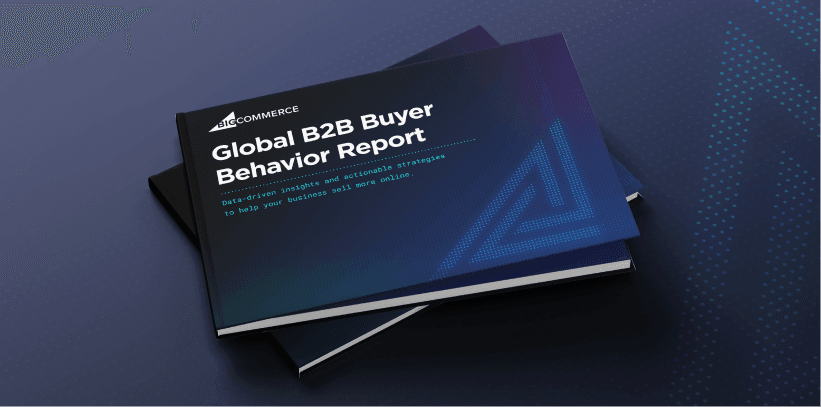by
The key to growth within a hybrid market is adaptation and agility. If your business isn’t continuously amplifying your services and brand, stagnation could lead to your demise.
To gain a competitive advantage in today’s evolving ecommerce ecosystem, B2B companies must significantly invest in resources, technologies, tools and strategies that scale operations and drive market exploration.
With Enterprise Resource Planning (ERP) software, you can engineer a system that preserves efficiency as your business grows.
ERP is the core technology that connects and organizes the critical functions of your B2B business, including accounting, finance, inventory, fulfillment, reporting, material management, customer and product data and more. Gartner predicted that 65% of organizations would use AI-integrated ERP systems by 2023.
Integrating ERP with B2B ecommerce is critical to successful expansion, creating a seamless experience between your physical and online store without disrupting the synchronization of other aspects of your business. It is the process of connecting ecommerce and ERP data and other sources, giving you the power to automate orders, inventory and customer data between the systems.
In centralizing and sharing information across systems, all team members can view live data, streamlining operations and improving team member collaboration, resulting in a more accurate and efficient experience for your customers and team.
Successfully integrating your strategies lends your business convenience, speed and personalization to meet customer expectations. In addition to access to robust data and increased productivity, to produce a single source of information and truth.
Important B2B ecommerce ERP integration features
Consolidating ecommerce data, inventory reports, order processing automation, shipping logistics and security between your ecommerce and ERP provides valuable insights through reporting and analytics, enabling efficient workflow automation and fully optimizing business operations.
Streamlined business processes.
B2B order workflows are often complex, involving invoicing, contracts and approvals. Some customers may need access to specific products, while others might need order limits and diverse shipping options.
Still, B2B customers prefer and expect an omnichannel, self-service experience that permits easy product discovery order management, shipment tracking and 24-hour access to purchase history and status updates. While the optimized web store makes it easy for customers to review products and orders, your team can assess your processes on an ongoing basis, improving conversion rates.
Each positive interaction builds trust in your brand. Even as your business grows and extends to new markets, you’ll have the flexibility to leverage new strategies and opportunities that maintain efficiency and a positive customer relationship.
Holistic inventory management.
Spikes in inventory demand create stock fluctuations. ERP software tracks inventory and orders, simplifying processes for handling product backorders and out-of-stock items. Wherein customers can place orders with reliable insights on stock availability.
Synching your ERP and ecommerce website provides buyers with up-to-date payment and order shipment information and avoids gaps in stock or holding onto unnecessary inventory. This exchange makes it possible to record and report accurate inventory levels across the entire catalog, facilitating positive, painless and seamless ecommerce site interactions for both customers and ecommerce staff.
Consolidation of data and processes.
All business processes rely on accurate data for insights into sales performance, inventory management and customer behavior. When your team has the data they need, when they need it, they can make informed decisions regarding product demand, inventory availability and supply chain forecasts.
Integrating disparate systems improves data visibility and streamlines workflows, resulting in customized sales and marketing reports. In synchronizing information across channels, you can speed up data collection and reduce discrepancies caused by isolated systems.
However, the success of business integration is dependent on your understanding of the data flow within your system. Seamless synchronization involves a two-way exchange between the ERP and ecommerce software. The two systems work together to capture more data, enabling your team to profile customers and engagement better.
Capture more of your revenue.
Excessive software, multiple data collection points and manual processes and entries can strain your system and cause costly errors and performance issues. A collaborative approach allows for automated order processing and financial management.
So when a customer orders through the ecommerce platform, the information is transferred to the ERP system for further processing, including inventory allocation, fulfillment and shipping.
Sales transactions, such as pricing, discounts and taxes, are also recorded in the ERP system for accurate accounting and financial reporting.
An optimized process means your team can spend less time on system maintenance, data sorting and productivity loss, and invest in lead generation, relationship nurturing, delivering a unique brand, new product offerings and a user experience that increases sales and revenue.
Free B2B Masterclass
Want to grow B2B online sales faster? Start now by enrolling in our free B2B Masterclass..
Essential B2B ecommerce ERP solution elements
Connecting your ERP and ecommerce platform may require fewer plugins and subsequent maintenance, lessening the stress and demand on your ERP for a more efficient process.
Industry-specific features.
Connecting your ERP with the right ecommerce platform gives you the flexibility to configure frontend data points to meet unique industry needs, including customizable workflows, product catalog management, labeling, regulatory certifications, unique pricing models and discounts, inventory and supply chain management and generating specific metrics.
For example, integration with a healthcare-specific system can help streamline product attributes such as medication dosage, order processing, FDA approvals or specialized shipping requirements for a logistics provider.
From a generalist system that caters to various industries to a modular approach that offers components based on business needs to ERP suites with a fusion of applications and specialized functions for large operations with broad functionality, you can choose the system that best suits your business model.
Integration options.
A range of options is available to integrate your B2B ecommerce platform with an ERP. These options include:
**API Integration:**Connect and optimize your entire technology stack using APIs that enable data exchange, functionality access and integration with external applications, such as CRM systems, payment gateways or logistics providers.
Middleware or Integration Platforms: Middleware or integration platforms act as intermediaries between ecommerce, ERP and other applications. These solutions provide pre-built connectors, adapters or tools that simplify the process and support data synchronization, workflow automation and seamless communication.
Standard Data Formats and Protocols: Standard data formats and protocols simplify integration with external systems with the same structures. It facilitates consistent data exchange, reducing compatibility issues.
Plugins and Extensions: Access plugins or extensions that expand the platform’s functionality and integration with specific third-party applications or services. These plugins often provide pre-built capabilities, configuration options and APIs for system integration with marketing automation or shipping providers.
When identifying the most compatible solution, consider the capabilities of your external applications and processes and which options will best enhance efficiency, productivity and profitability.
Composable options.
A composable B2B ecommerce ERP option empowers businesses to assemble, select, integrate and modify components to fit specific requirements. It breaks processes into smaller modular segments with distinct functions like inventory or procurement. Allowing you to loosely couple modules and independently deploy functions.
Choose and combine modules that align with your requirements to tailor the integration to your unique workflows and industry specifications. Instead of being locked into a singular ERP suite, you can build a system that meets changing needs over time, ensuring that the solution remains aligned with your unique processes and goals.
Leverage and integrate software solutions that create a cohesive technology ecosystem that evolves as needs change so you can take action when unexpected circumstances and emerging opportunities arise.
B2B ecommerce ERP integration challenges to watch
B2B ecommerce ERP integration is so significant to the success of your operations that failure and oversight can derail the entire process. Staying ahead of these potential challenges help your team pinpoint issues early on and implement adaptations that decrease resource strain and maintain system efficiency.
Integration with legacy systems.
Legacy systems sometimes lack features or functionalities to support real-time data synchronization and automated workflows. Handling large volumes of transactions may be difficult without the capabilities to support a seamless process, necessitating costly, time-consuming customization.
With data formats or structures that differ from modern ecommerce or ERP systems, mapping and transformation require cleansing and reformatting to align data.
If the system is outdated or is no longer supported by the original vendor, technical support, resources or familiarity with the software may be insufficient, limiting stability, security, maintenance and compatibility with new technologies.
Furthermore, legacy systems are often deeply ingrained within organizations, creating resistance and reluctance to invest in modern software.
To address these challenges, carefully evaluate the legacy system’s capacity against the integration requirements and explore potential workarounds solutions such as custom code or middleware to bridge the gap.
Syncing issues.
Data synchronization requires significant time and extensive testing before a system is ready to go live. But the process can be demanding when dealing with high transaction volumes or complex data structures.
You may opt for real-time synchronization, which supports the immediate integration of time-sensitive data and frequent, large transactions or batch integration and process data at once based on criteria.
No matter your chosen method, you will need a high-speed network connection to avoid delays or lags that create inconsistencies and impede performance.
Data migration is an ongoing process that demands extensive development skills, knowledge and resources. Understand your data flow to identify contingencies for future adaptations. Changes in data structures, APIs or integration methods between different systems may require adjustments to the synchronization process, testing and potential reconfiguration.
B2B ecommerce and ERP systems often operate in parallel but may use different formats or structures. For instance, discrepancies in product SKUs or customer data. Consider a synchronization strategy and workflow diagrams for a visual of how your systems should work together.
Security and compliance requirements.
Integrating B2B ecommerce and ERP systems introduce potential vulnerabilities and security risks as the process often involves permitting multiple vendors and third-party service providers access to sensitive business information such as customer data, financial records and proprietary files.
Industry regulations and compliance requirements also impact integration. For businesses that process international transactions, failure to adhere to various tax codes, rates and rules can put your business at risk for increased regulatory issues.
Appropriate security measures like encryption, access controls, audits and secure data transmission protocols are crucial for a compliant, safe integration process that protects data from unauthorized access.
Data accuracy during migration.
B2B ecommerce and ERP systems contain vast information, including product catalogs, online orders and inventory data. The more data fields, the more complex the integration. Each system may have varying terminology, naming conventions or data representations.
Migrating large volumes of data while maintaining accuracy can be difficult, especially when dealing with complicated relationships or dependencies between entities. Incompatible formats or structures result in data loss, truncation or misinterpretation during migration.
For improved accuracy, establish a comprehensive migration plan to determine how you will pursue the process. Identify what you want to include (product information, customer accounts, etc.), clarify the importance of sharing this data, which sources will send and receive information and the migration frequency.
Data cleansing, validation steps, mapping, transformation rules, reconciliation procedures and thorough testing are essential to resolve issues and entry oversight and avoid transferring flawed and duplicate information into an integrated system.
A New Approach for New Expectations
BigCommerce’s B2B ecommerce platform enables you with powerful features to readily meet — and exceed — your buyers’ expectations.
The final word
When considering your next B2B ecommerce solution, ERP integration should be a top priority for scalability and optimization.
Growing your online business is a good sign for your bottom line, but can burden your operations, slow down performance and create a negative customer experience. However, an integrated system consolidates data, automates processes, reduces errors, streamlines sales, saves your ecommerce business money and gives you a competitive edge in the future of online retail.



